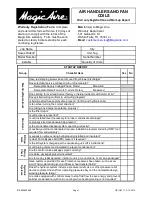
12
| Intended use and range of applications
G
Intended use and range of applications
The air handling units are intended for transport and treatment of air between -40 °C and + 40 °C The units are exclu-
sively for comfort ventilation. The units are not for environments that exceed the corrosion class C4 according to EN ISO
12944-2 (motors are constructed for handling of air between -20 °C and + 60 °C).
Intended applications for the units are:
• Offices
• teaching rooms
• hotels
• shops
• homes and similar comfort zones
H
Unintended use and misuse – inappropriate applications for the machine
Units for outdoor installation must be specified and ordered for outdoor installation. The units must not be used in envi-
ronments that exceed corrosion class C4 according to EN ISO 12944-2, and for transport of solid particles.
Examples of not intended use:
• Kitchen extraction
• swimming pools
• off-shore
• Ex-areas
• drying of washed clothes.
• Do not use the unit with partly finished duct systems.
• Do not use the unit for ventilation of the building site until the unit is properly provided with guards.
H.1
Air handling unit in operation
The pressure difference between interior and exterior of the unit must not exceed 2000 Pa for the Geniox Core 10 and
up to 20 (including 20 ).
Before start-up of the unit all ducts, safety guards and all protective devices must be mounted to prevent any access to
rotating fan impellers. All inspection doors must be closed and locked when the unit is in operation.
Do not use the unit without filters.
I
Instructions for unloading on the site as well as installation and connection
I.1
Unloading on the site
The air handling unit – AHU - is delivered as one section or in several sections, which are to be assembled on the build-
ing site. The AHU is delivered on transport pallets, legs, base frame with brackets for lifting or base frames with holes
for forks on forklift trucks or manual hydraulic hand trucks. Loading and unloading as well as transport on the building
site is possible by forklift truck, manual hydraulic hand trucks or by crane using suitable lifting straps.
I.1.1
Handling methods
Possible (
) and not possible (
) handling methods are described in the table below.
Type
Handling methods
Forklift
Lifting by
straps
Brackets at
base frame
for lifting
Hoist holes in
base frames
Holes in base
frames for
forks (option)
Corners in
sections for
lifting
Sections on
pallets
Sections on
base frames
Unit on base
frame
output |










































